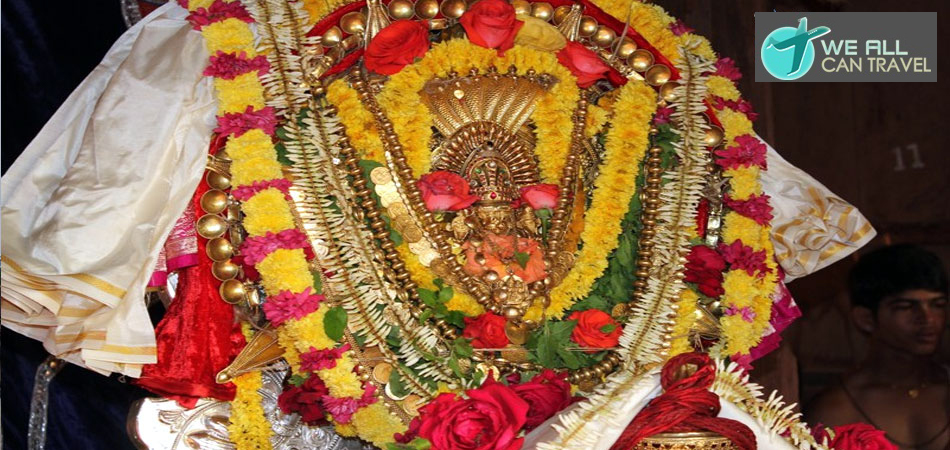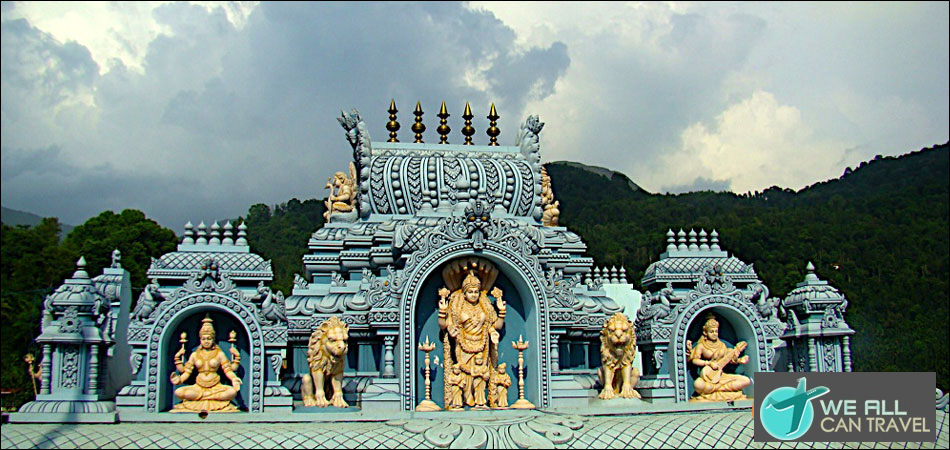Kanya Devi Temple
The first Durga Temple created by Lord Parasurama and is also one among the 108 Shakthi Peethas in the world. Kanya Devi temple is dedicated to Parvati as Devi Kanya The Virgin Goddess (The name Kanyakumari stands for Kanya(Virgin) and Kumari(girl) ) who did penance to obtain the hand of Lord Shiva. The temple is situated on the beach and there are long queues to enter the temple. The bright diamond nose ring of the Goddess is world famous The nose ring reflects a powerful beam out to sea. Nearby the footprints of Kanya Devi are also visible. It is especially auspicious for pilgrims to wash at the bathing ghat here.
The demon king Banasura(grand son of Mahabali) did penance to get a boon from Lord Shiva. He obtained a boon from Lord Shiva that he could be vanquished only by a virgin. Later he became the emperror of the three worlds. His evil ways had caused much agony to Devas,sages and saints. Unable to bear the harassment of the demon king Bhoomi Devi(Mother Earth) and the Devas approached Lord Vishnu and requested him to kill Banasura. Mahavishnu advised them to worship Sathi(Parvathy) the Goddess of the universe to vanquish the demon. Answering the prayers of the oppressed, Shakti appeared as Kumari(a young virgin girl) and promised to annihilate the evil forces championed by Banasura. Asking the devas to be patient for the right time for the killing of Banasura, Devi travelled to the southern-most tip of India, where she began to meditate upon Lord Shiva. As time went on she grew into a teenager. This is how the southern tip of India got the name Kanya Kumari, as kanya kumari means "a virgin teenaged girl" at Kanyakumari and commenced penance with the desire of marrying Shiva at Suchindram.
Lord Shiva (from nearby Suchindrum) was so enchanted by the beauty of Goddess Kumari that he decided to marry her. The divine sage, Narada, felt this would endanger the chances of destroying Banasura, for it was preordained that the king of demons could meet his death only at the hands of a virgin. Therefore, Narada had to find someway to scuttle the marriage.
First Narada tried to confuse Kanya Kumari, telling her that Shiva is not powerful than Banasura. Narada told the goddess that she should ask Shiva to bring three items that could not be obtained anywhere in the world in order to prove his identity. These were a coconut without eyes, a stalk of sugarcane without stump-joints and a betel leaf without veins. But Lord Shiva easily fulfilled this difficult challenge and the marriage continued to be scheduled.
Narada, fixed the midnight hour as the auspicious time for the wedding. When Shiva's procession reached a site by name Vazhukkumpaarai, Narada falsely heralded the break of dawn by assuming the form of a cock. On hearing the crowing of thr cock, Lord Shiva presumed the auspicious hour had past, turned back and returned to Suchindrum. Meanwhile, in Kanyakumari all waited for Lord Shiva's arrival and eventually, when he didn't turn up, the wedding ceremonies were cancelled. The rice and other grains meant for the wedding feast remained uncooked. It is said that in Kanya Kumari's anger over Shiva not arriving that she scattered all the food items that had been assembled for the wedding. Today tourists can buy tiny stones which look like rice, in remembrance of the marriage that was never solemnized.
The disappointed Kumari Devi decided to do penance and continue with her quest to fight the evil forces of Banasura. The Devi resumed Her penance on the rock, now known as Sripadaparai, a few hundred metres offshore. Meanwhile, Banasura heard about the beauty of the girl and came to request Her hand in marriage. When Devi rejected the idea, the demon king decided to win her by force. This led to a fierce battle, which ended with Kanya Kumari slaying Banasura with her chakra (divine discus) in Mahadana Puram (4 km north of Kanya Kumari).
It is said that at the moment of his death, Banasura repented for his adharmic acts and prayed to Parashakti to have compassion upon him and absolve him and anyone else who bathed in the waters off Kanya Kumari of their sins. Devi granted Banasura the boon, and this is why people come from all over the world to bathe in this holy confluence of seas. The relieved Devas returned blessed. Lord Parasurama and Sage Narada requsted to stay there till the end of Kaliyuga. The goddess agreed and remains at this place ever-dedicated to Lord Shiva and continues to perform austerities to this day with the hopes that he will one day unite with her. Later Parasurama built a temple on the shores and installed a beautiful idol of Goddess Kanya Kumari. The beautiful image of the Goddess in resplendent glory, with a garland in her right hand doing eternal penance as she waits for Lord Shiva to come, bestows on the devotee immense wealth of spiritual energy and peace of mind.
One specialty of the idol is her diamond nose ring. The sparkling diamond nose-ring of the deity is said to be visible even from the sea. The temple's legend says that the nose ring was obtained from a king cobra and that light reflects off it so brightly that once an ancient mariner mistook it for a lighthouse. Sailing his ship towards the beacon, he wrecked upon the Kanya Kumari rocks. In order to prevent such a tragedy from happening again, the eastern door of the temple is only opened on five special occasions throughout the year.
Lord Ganesha, Surya and Ayyappa have separate shrines. There are also shrines to Vijayasundari and Balasundari, friends and playmates of the Goddess in her youthful form. A well inside the temple known as Moola Ganga Theertham, provides water for the Devi's abhishekam. The eastern entrance, facing the sea, remains closed throughout the year except for the Aaraattu rituals. The eastern door is opened also on new moon days in the months of Edavam, Karkkidakam (Capricorn and Cancer), during Navaratri and in the month of Vrischikam.
The Kanyakumari temple remains open for public from 4.30 AM to 11.45 AM and 5.30 PM to 8.45 PM .
 >> Agasteeshwara Temple
>> Agasteeshwara Temple >> Anantha Padmanabhaswami Temple
>> Anantha Padmanabhaswami Temple >> Ananthasana Temple
>> Ananthasana Temple >> Annapoorneshwari Temple
>> Annapoorneshwari Temple >> Arunachaleshwar Temple
>> Arunachaleshwar Temple